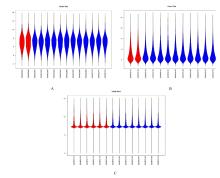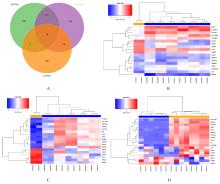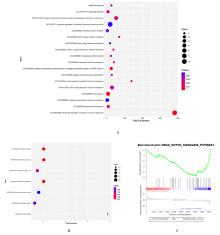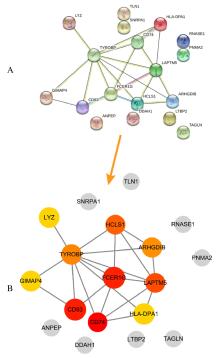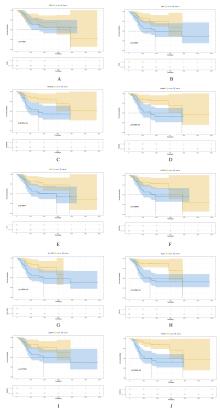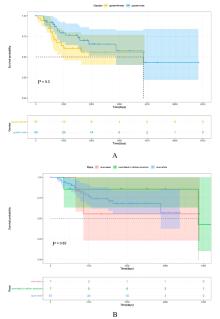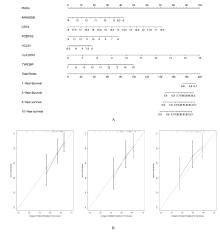| 1 |
GDOWSKI A S, RANJAN A, VISHWANATHA J K. Current concepts in bone metastasis, contemporary therapeutic strategies and ongoing clinical trials[J]. J Exp Clin Cancer Res, 2017, 36: 108.
|
| 2 |
MESSERSCHMITT P J, GARCIA R M, ABDUL-KARIM F W, et al. Osteosarcoma[J]. J Am Acad Orthop Surg, 2009, 17(8): 515-527.
|
| 3 |
LIN Y H, JEWELL B E, GINGOLD J, et al. Osteosarcoma: molecular pathogenesis and iPSC modeling[J]. Trends Mol Med, 2017, 23(8): 737-755.
|
| 4 |
LI W, YUAN B, ZHAO Y, et al. Transcriptome profiling reveals target in primary myelofibrosis together with structural biology study on novel natural inhibitors regarding JAK2[J]. Aging (Albany NY),2021,13(6): 8248-8275.
|
| 5 |
何 远, 张丽娜, 朱兴文. 大数据技术在生物信息学中的应用综述[J]. 软件导刊, 2016, 15(4): 147-148.
|
| 6 |
GAUTIER L, COPE L, BOLSTAD B M, et al. Affy: analysis of Affymetrix GeneChip data at the probe level[J]. Bioinformatics, 2004, 20(3): 307-315.
|
| 7 |
COLAPRICO A, SILVA T C, OLSEN C, et al. TCGAbiolinks: an R/Bioconductor package for integrative analysis of TCGA data[J]. Nucleic Acids Res, 2016, 44(8): e71.
|
| 8 |
DENNIS G, SHERMAN B T, HOSACK D A, et al. DAVID: database for annotation, visualization, and integrated discovery[J]. Genome Biol, 2003, 4(5): P3.
|
| 9 |
SZKLARCZYK D, GABLE A L, LYON D, et al. STRING v11: protein-protein association networks with increased coverage, supporting functional discovery in genome-wide experimental datasets[J]. Nucleic Acids Res, 2019, 47(d1): D607-D613.
|
| 10 |
CHIN C H, CHEN S H, WU H H, et al. cytoHubba: identifying hub objects and sub-networks from complex interactome[J]. BMC Syst Biol, 2014, 8(): S11.
|
| 11 |
ARNDT C A, ROSE P S, FOLPE A L, et al. Common musculoskeletal tumors of childhood and adolescence[J]. Mayo Clin Proc, 2012,87(5): 475-487.
|
| 12 |
SAMPO M, KOIVIKKO M, TASKINEN M, et al. Incidence, epidemiology and treatment results of osteosarcoma in Finland - a nationwide population-based study[J]. Acta Oncol, 2011, 50(8): 1206-1214.
|
| 13 |
PICCI P. Osteosarcoma (osteogenic sarcoma)[J]. Orphanet J Rare Dis, 2007, 2: 6.
|
| 14 |
XI L, ZHANG Y F, KONG S N, et al. miR-34 inhibits growth and promotes apoptosis of osteosarcoma in nude mice through targetly regulating TGIF2 expression[J]. Biosci Rep, 2018, 38(3):BSR20180078.
|
| 15 |
LUETKE A, MEYERS P A, LEWIS I, et al. Osteosarcoma treatment - Where do we stand? A state of the art review[J]. Cancer Treat Rev, 2014, 40(4): 523-532.
|
| 16 |
任 娟, 徐叶峰, 匡唐洪, 等. 104例骨肉瘤肺转移患者的预后及其影响因素[J].中华肿瘤杂志, 2017,39(4): 263-268.
|
| 17 |
YANG L, LI W, ZHAO Y, et al. Computational study of novel natural inhibitors targeting O6-methylguanine-DNA methyltransferase[J]. World Neurosurg, 2019, 130: e294-e306.
|
| 18 |
ZHONG S, LI W H, BAI Y, et al. Computational study on new natural compound agonists of stimulator of interferon genes(STING)[J].PLoS One,2019,14(5):e0216678.
|
| 19 |
MOEK K L, DE GROOT D J A, DE VRIES E G E, et al. The antibody-drug conjugate target landscape across a broad range of tumour types[J]. Ann Oncol, 2017, 28(12): 3083-3091.
|
| 20 |
BUDDINGH E P, RUSLAN S E N, REIJNDERS C M A, et al. Mesenchymal stromal cells of osteosarcoma patients do not show evidence of neoplastic changes during long-term culture[J]. Clin Sarcoma Res, 2015, 5: 16.
|
| 21 |
PAN Y, LU L, CHEN J,et al. Identification of potential crucial genes and construction of microRNA-mRNA negative regulatory networks in osteosarcoma[J]. Hereditas, 2018, 155: 21.
|
| 22 |
HENCKAERTS L, CLEYNEN I, BRINAR M, et al. Genetic variation in the autophagy gene ULK1 and risk of Crohnʼs disease[J]. Inflamm Bowel Dis, 2011, 17(6): 1392-1397.
|
| 23 |
BILALIC S, VEITINGER M, AHRER K H, et al. Identification of Non-HLA antigens targeted by alloreactive antibodies in patients undergoing chronic hemodialysis[J]. J Proteome Res, 2010, 9(2): 1041-1049.
|
| 24 |
LIU S S, CUI H, LI Q L, et al. RhoGDI2 is expressed in human trophoblasts and involved in their migration by inhibiting the activation of RAC1[J]. Biol Reprod, 2014, 90(4): 88.
|
| 25 |
ZHU H, WU H, LIU X, et al. Regulation of autophagy by a beclin 1-targeted microRNA, miR-30a, in cancer cells[J]. Autophagy, 2009, 5(6): 816-823.
|
| 26 |
SWEET R A, NICKERSON K M, CULLEN J L,et al. B cell–extrinsic Myd88 and Fcer1g negatively regulate autoreactive and normal B cell immune responses[J]. J Immunol, 2017, 199(3): 885-893.
|
| 27 |
LE CONIAT M, KINET J P, BERGER R. The human genes for the alpha and gamma subunits of the mast cell receptor for immunoglobulin E are located on human chromosome band 1q23[J]. Immunogenetics, 1990, 32(3): 183-186.
|
| 28 |
RAJARAMAN P, BRENNER A V, NETA G, et al. Risk of meningioma and common variation in genes related to innate immunity[J]. Cancer Epidemiol Biomarkers Prev, 2010, 19(5): 1356-1361.
|
| 29 |
MAHACHIE JOHN J M, BAURECHT H, RODRÍGUEZ E, et al. Analysis of the high affinity IgE receptor genes reveals epistatic effects of FCER1A variants on eczema risk[J]. Allergy, 2010, 65(7): 875-882.
|
| 30 |
HAN S, LAN Q, PARK A K, et al. Polymorphisms in innate immunity genes and risk of childhood leukemia[J]. Hum Immunol, 2010, 71(7): 727-730.
|
| 31 |
CHEN L, YUAN L, WANG Y, et al. Co-expression network analysis identified FCER1G in association with progression and prognosis in human clear cell renal cell carcinoma[J]. Int J Biol Sci, 2017, 13(11): 1361-1372.
|
| 32 |
PALONEVA J, KESTILÄ M, WU J, et al. Loss-of-function mutations in TYROBP (DAP12) result in a presenile dementia with bone cysts[J]. Nat Genet, 2000, 25(3): 357-361.
|
| 33 |
HAMERMAN J A, NI M J, KILLEBREW J R, et al. The expanding roles of ITAM adapters FcRgamma and DAP12 in myeloid cells[J]. Immunol Rev, 2009, 232(1): 42-58.
|
| 34 |
施锦涛,张 凯,张芮浩,等.PD-1/PD-L1轴与骨肉瘤治疗研究进展[J].解放军医学杂志,2021,46(1):89-94.
|
| 35 |
HAURE-MIRANDE J V, AUDRAIN M, FANUTZA T, et al. Deficiency of TYROBP, an adapter protein for TREM2 and CR3 receptors, is neuroprotective in a mouse model of early Alzheimer’s pathology[J]. Acta Neuropathol, 2017, 134(5): 769-788.
|
 )
)
 )
)
